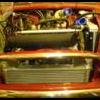Hi guys, i have a silly question. I want to perform a simple voltage drop test to rule out excessive resistance.
Symptoms on my 92 Spi: Crank getting weaker and weaker. Battery 12.65V after 8hours, 14V at engine idle. Battery earth strap checked and cleaned, extra earth strap added from alternator mount to (paint free) body. Solenoid/Battery terminal to Solenoid case 12.65V. Shorted Solenoid/Battery terminal with Solenoid/Starter terminal and the motor seems to whir smoothly/freely.
I guess I'm just missing a voltage drop test for a definitive answer. In my mind, + lead to + battery post, - lead to starter battery feed terminal. If there's a >0.5V then at least i know the wiring is suspect. But is there anything else i could test? And how do i get test leads that are long enough!
Kopi
















